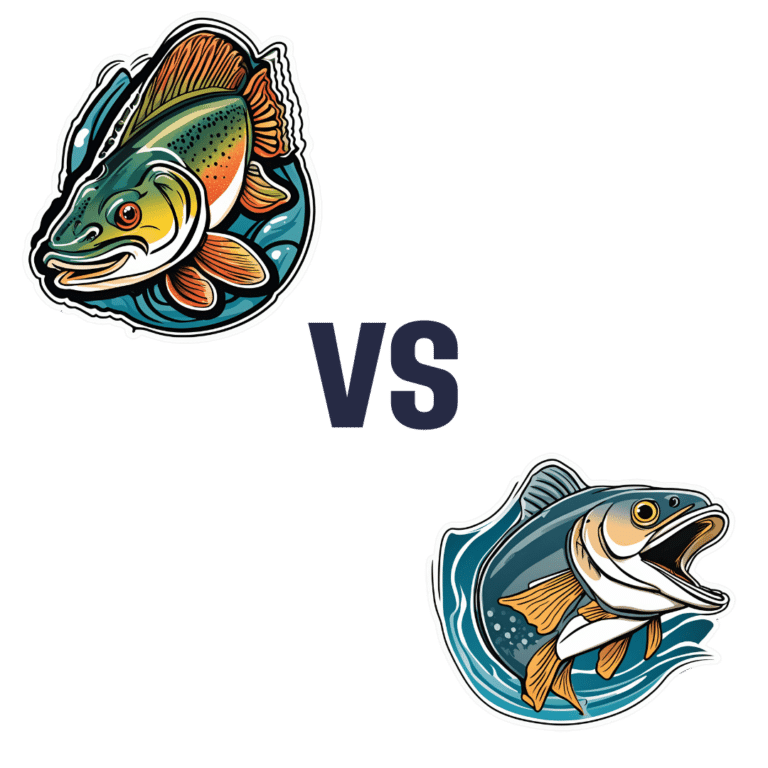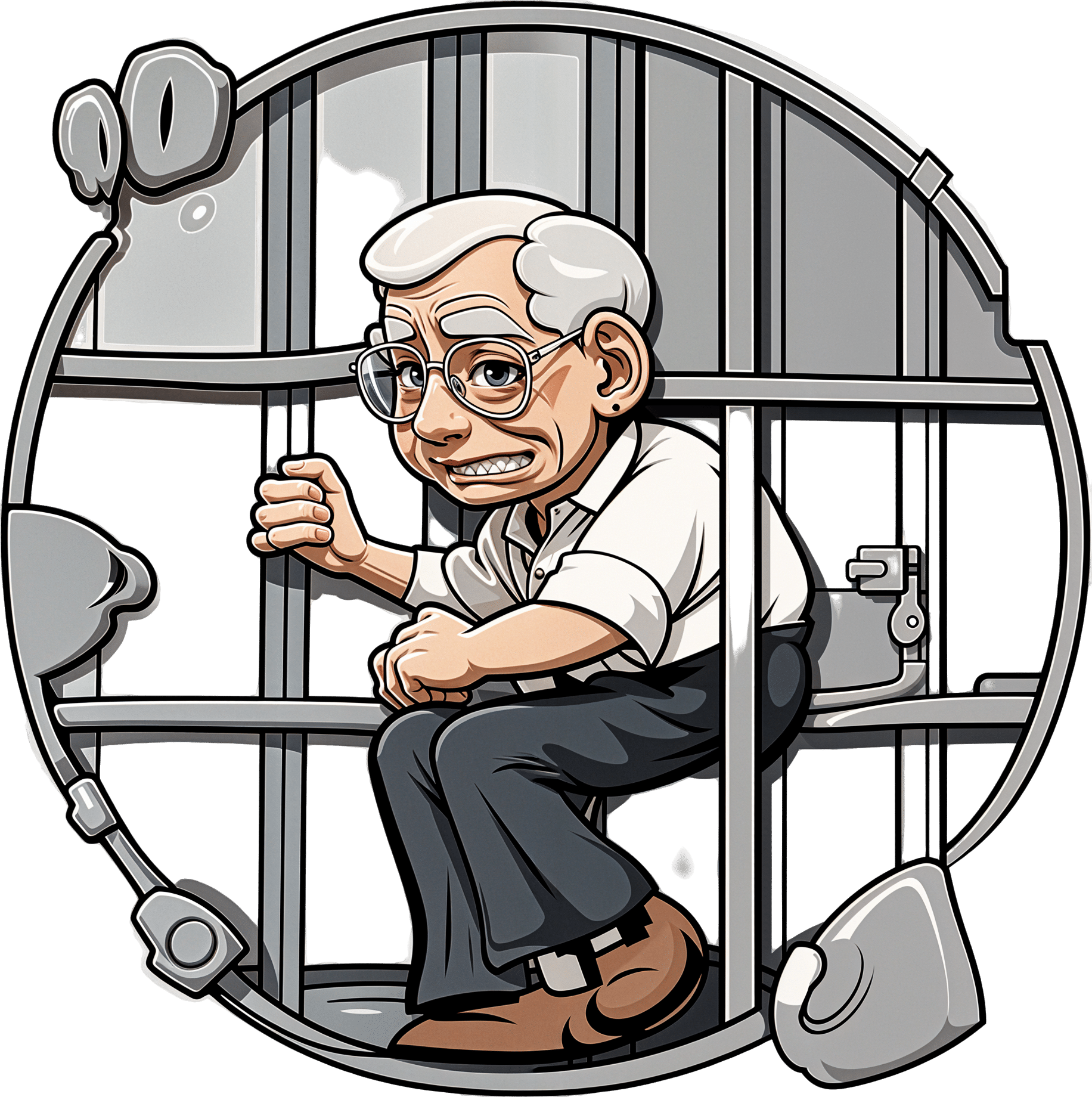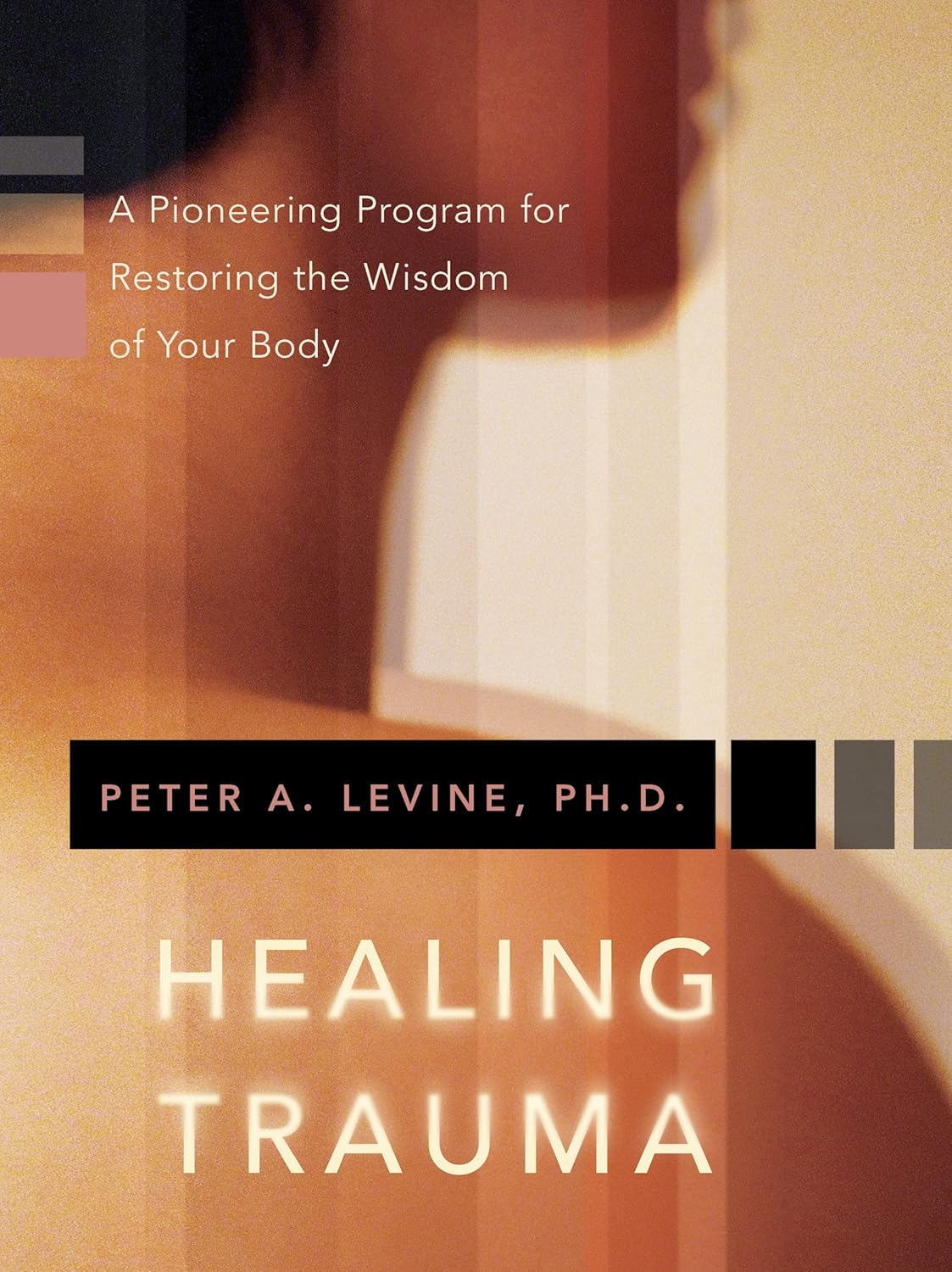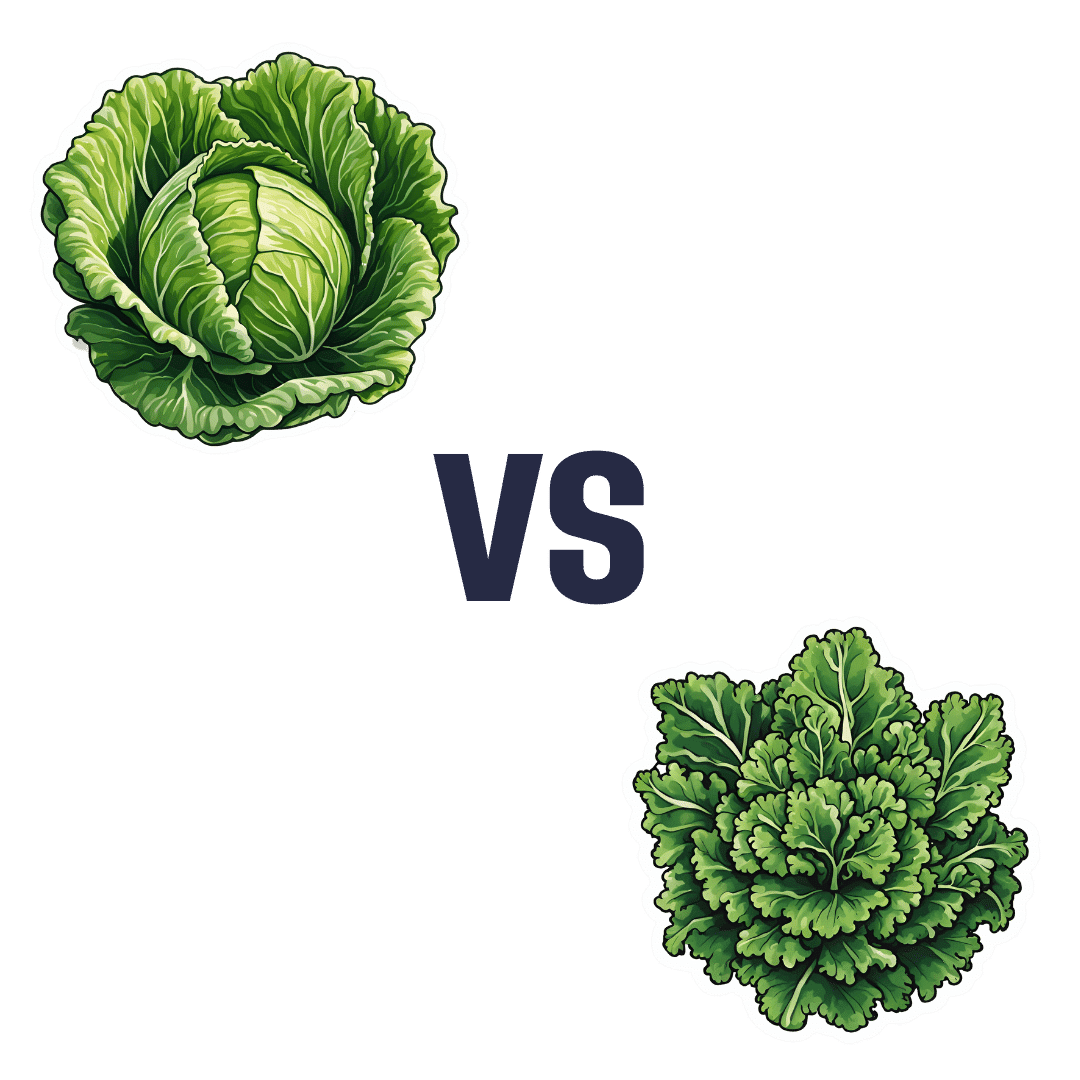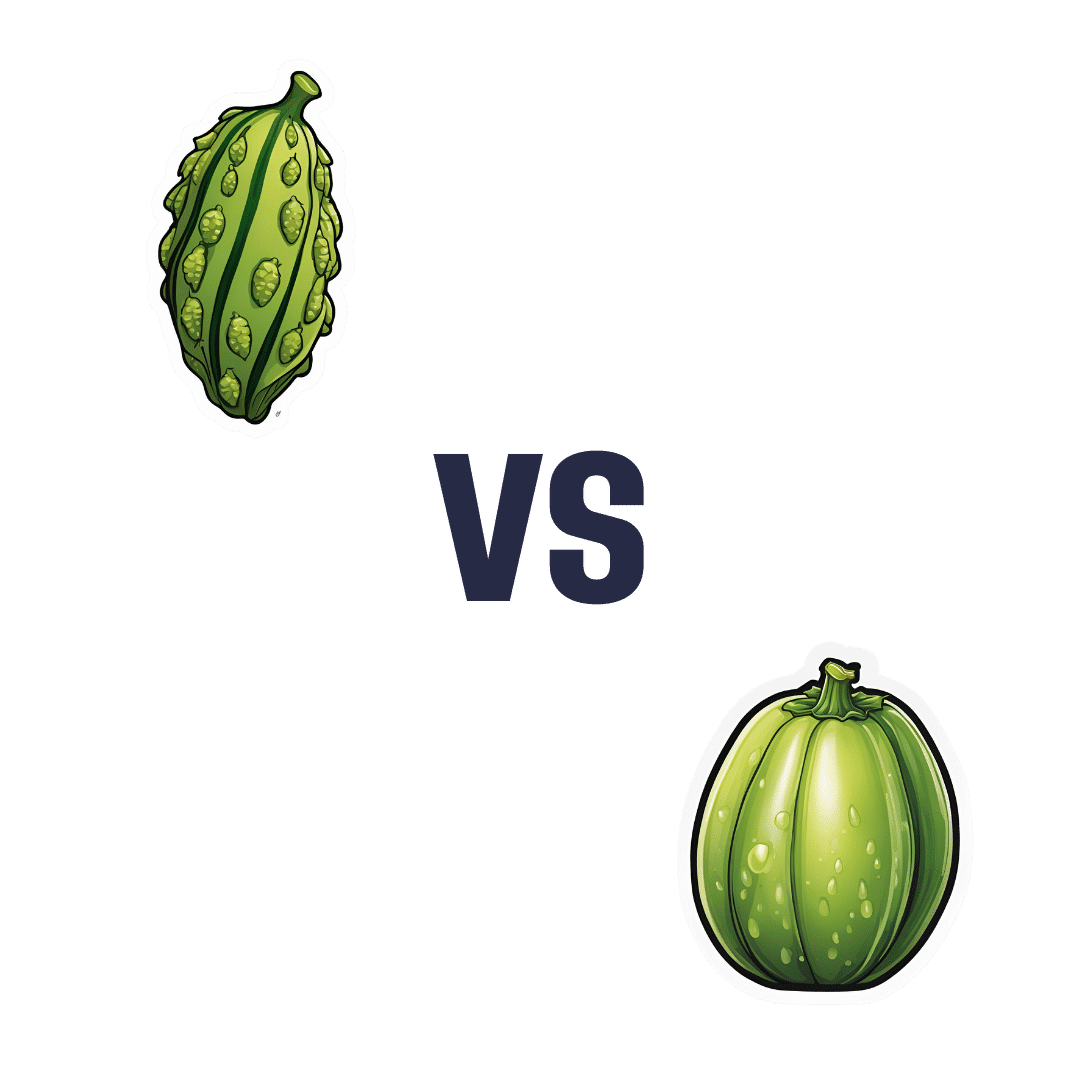
Bitter Melon vs Winter Melon – Which is Healthier?
10almonds is reader-supported. We may, at no cost to you, receive a portion of sales if you purchase a product through a link in this article.
Our Verdict
When comparing bitter melon to winter melon, we picked the bitter.
Why?
Did you remember the “bitter is better” dictum that goes for most plant-based foods? It certainly stands in this case!
A note on nomenclature before we begin: these two fruits are also known as the bitter gourd and the wax gourd, respectively (amongst many other names for each), but we went with what seems to be their most common names.
In terms of macros, the bitter melon has more than 13x the protein (and actually adding up to a meaningful amount, at 5.3g/100g), as well as more fiber for the same carbs, making it the better choice all around.
When it comes to vitamins, the bitter melon has a lot more of vitamins A, B1, B2, B3, B6, B7, B9, and C, while the winter melon boasts only more vitamin B5. As in, the vitamin that’s in all foods (even its scientific name means “from everywhere”) and in which it’s pretty much impossible to be deficient unless literally starving. All in all, an easy and clear win for bitter melon.
In the category of minerals, we see a similar story: the bitter melon has very much more calcium, copper, iron, magnesium, manganese, phosphorus, potassium, and selenium, while the winter melon has a modest double-dose of zinc—hardly comparable to, say, bitter melon having over 100x the potassium content, and indeed, in all minerals except zinc, bitter melon had 4x–100x more. Another clear and overwhelming win for the bitter melon.
Looking up polyphenols, we see that the bitter melon also wins in that regard, shocking nobody, with an impressive polyphenolic profile, especially rich in luteolins and catechins of various kinds.
In short, enjoy either or both, but there’s a clear winner here, and it’s the bitter melon.
Want to learn more?
You might like to read:
Enjoy Bitter Foods For Your Heart & Brain
Enjoy!
Don’t Forget…
Did you arrive here from our newsletter? Don’t forget to return to the email to continue learning!
Recommended
Learn to Age Gracefully
Join the 98k+ American women taking control of their health & aging with our 100% free (and fun!) daily emails:
-
Successful Aging – by Dr. Daniel Levitin
10almonds is reader-supported. We may, at no cost to you, receive a portion of sales if you purchase a product through a link in this article.
We all know about age-related cognitive decline. What if there’s a flipside, though?
Neuroscientist Dr. Daniel Levitin explores the changes that the brain undergoes with age, and notes that it’s not all downhill.
From cumulative improvements in the hippocampi to a dialling-down of the (often overfunctioning) amygdalae, there are benefits too.
The book examines the things that shape our brains from childhood into our eighties and beyond. Many milestones may be behind us, but neuroplasticity means there’s always time for rewiring. Yes, it also covers the “how”.
We learn also about the neurogenesis promoted by such simple acts as taking a different route and/or going somewhere new, and what other things improve the brain’s healthspan.
The writing style is very accessible “pop-science”, and is focused on being of practical use to the reader.
Bottom line: if you want to get the most out of your aging wizening brain, this book is a great how-to manual.
Click here to check out Successful Aging and level up your later years!
Share This Post
-
Older Americans Say They Feel Trapped in Medicare Advantage Plans
10almonds is reader-supported. We may, at no cost to you, receive a portion of sales if you purchase a product through a link in this article.
In 2016, Richard Timmins went to a free informational seminar to learn more about Medicare coverage.
“I listened to the insurance agent and, basically, he really promoted Medicare Advantage,” Timmins said. The agent described less expensive and broader coverage offered by the plans, which are funded largely by the government but administered by private insurance companies.
For Timmins, who is now 76, it made economic sense then to sign up. And his decision was great, for a while.
Then, three years ago, he noticed a lesion on his right earlobe.
“I have a family history of melanoma. And so, I was kind of tuned in to that and thinking about that,” Timmins said of the growth, which doctors later diagnosed as malignant melanoma. “It started to grow and started to become rather painful.”
Timmins, though, discovered that his enrollment in a Premera Blue Cross Medicare Advantage plan would mean a limited network of doctors and the potential need for preapproval, or prior authorization, from the insurer before getting care. The experience, he said, made getting care more difficult, and now he wants to switch back to traditional, government-administered Medicare.
But he can’t. And he’s not alone.
“I have very little control over my actual medical care,” he said, adding that he now advises friends not to sign up for the private plans. “I think that people are not understanding what Medicare Advantage is all about.”
Enrollment in Medicare Advantage plans has grown substantially in the past few decades, enticing more than half of all eligible people, primarily those 65 or older, with low premium costs and perks like dental and vision insurance. And as the private plans’ share of the Medicare patient pie has ballooned to 30.8 million people, so too have concerns about the insurers’ aggressive sales tactics and misleading coverage claims.
Enrollees, like Timmins, who sign on when they are healthy can find themselves trapped as they grow older and sicker.
“It’s one of those things that people might like them on the front end because of their low to zero premiums and if they are getting a couple of these extra benefits — the vision, dental, that kind of thing,” said Christine Huberty, a lead benefit specialist supervising attorney for the Greater Wisconsin Agency on Aging Resources.
“But it’s when they actually need to use it for these bigger issues,” Huberty said, “that’s when people realize, ‘Oh no, this isn’t going to help me at all.’”
Medicare pays private insurers a fixed amount per Medicare Advantage enrollee and in many cases also pays out bonuses, which the insurers can use to provide supplemental benefits. Huberty said those extra benefits work as an incentive to “get people to join the plan” but that the plans then “restrict the access to so many services and coverage for the bigger stuff.”
David Meyers, assistant professor of health services, policy, and practice at the Brown University School of Public Health, analyzed a decade of Medicare Advantage enrollment and found that about 50% of beneficiaries — rural and urban — left their contract by the end of five years. Most of those enrollees switched to another Medicare Advantage plan rather than traditional Medicare.
In the study, Meyers and his co-authors muse that switching plans could be a positive sign of a free marketplace but that it could also signal “unmeasured discontent” with Medicare Advantage.
“The problem is that once you get into Medicare Advantage, if you have a couple of chronic conditions and you want to leave Medicare Advantage, even if Medicare Advantage isn’t meeting your needs, you might not have any ability to switch back to traditional Medicare,” Meyers said.
Traditional Medicare can be too expensive for beneficiaries switching back from Medicare Advantage, he said. In traditional Medicare, enrollees pay a monthly premium and, after reaching a deductible, in most cases are expected to pay 20% of the cost of each nonhospital service or item they use. And there is no limit on how much an enrollee may have to pay as part of that 20% coinsurance if they end up using a lot of care, Meyers said.
To limit what they spend out-of-pocket, traditional Medicare enrollees typically sign up for supplemental insurance, such as employer coverage or a private Medigap policy. If they are low-income, Medicaid may provide that supplemental coverage.
But, Meyers said, there’s a catch: While beneficiaries who enrolled first in traditional Medicare are guaranteed to qualify for a Medigap policy without pricing based on their medical history, Medigap insurers can deny coverage to beneficiaries transferring from Medicare Advantage plans or base their prices on medical underwriting.
Only four states — Connecticut, Maine, Massachusetts, and New York — prohibit insurers from denying a Medigap policy if the enrollee has preexisting conditions such as diabetes or heart disease.
Paul Ginsburg is a former commissioner on the Medicare Payment Advisory Commission, also known as MedPAC. It’s a legislative branch agency that advises Congress on the Medicare program. He said the inability of enrollees to easily switch between Medicare Advantage and traditional Medicare during open enrollment periods is “a real concern in our system; it shouldn’t be that way.”
The federal government offers specific enrollment periods every year for switching plans. During Medicare’s open enrollment period, from Oct. 15 to Dec. 7, enrollees can switch out of their private plans to traditional, government-administered Medicare.
Medicare Advantage enrollees can also switch plans or transfer to traditional Medicare during another open enrollment period, from Jan. 1 to March 31.
“There are a lot of people that say, ‘Hey, I’d love to come back, but I can’t get Medigap anymore, or I’ll have to just pay a lot more,’” said Ginsburg, who is now a professor of health policy at the University of Southern California.
Timmins is one of those people. The retired veterinarian lives in a rural community on Whidbey Island just north of Seattle. It’s a rugged, idyllic landscape and a popular place for second homes, hiking, and the arts. But it’s also a bit remote.
While it’s typically harder to find doctors in rural areas, Timmins said he believes his Premera Blue Cross plan made it more challenging to get care for a variety of reasons, including the difficulty of finding and getting in to see specialists.
Nearly half of Medicare Advantage plan directories contained inaccurate information on what providers were available, according to the most recent federal review. Beginning in 2024, new or expanding Medicare Advantage plans must demonstrate compliance with federal network expectations or their applications could be denied.
Amanda Lansford, a Premera Blue Cross spokesperson, declined to comment on Timmins’ case. She said the plan meets federal network adequacy requirements as well as travel time and distance standards “to ensure members are not experiencing undue burdens when seeking care.”
Traditional Medicare allows beneficiaries to go to nearly any doctor or hospital in the U.S., and in most cases enrollees do not need approval to get services.
Timmins, who recently finished immunotherapy, said he doesn’t think he would be approved for a Medigap policy, “because of my health issue.” And if he were to get into one, Timmins said, it would likely be too expensive.
For now, Timmins said, he is staying with his Medicare Advantage plan.
“I’m getting older. More stuff is going to happen.”
There is also a chance, Timmins said, that his cancer could resurface: “I’m very aware of my mortality.”
KFF Health News is a national newsroom that produces in-depth journalism about health issues and is one of the core operating programs at KFF—an independent source of health policy research, polling, and journalism. Learn more about KFF.
Subscribe to KFF Health News’ free Morning Briefing.
Share This Post
-
Healing Trauma – by Dr. Peter Levine
10almonds is reader-supported. We may, at no cost to you, receive a portion of sales if you purchase a product through a link in this article.
Dr. Levine’s better-selling book about trauma, Waking The Tiger, laid the foundations for this one, but the reason we’re skipping straight into Healing Trauma, is that while the former book is more about the ideas that led him to what he currently believes is the best approach to healing trauma, this book is the one that explains how to actually do it.
The core thesis is that trauma is a natural, transient response, and is not inherently pathological, but that it can become so if not allowed to do its thing.
This book outlines exercises, trademarked as “somatic experiencing”, which allow the body to go through the physiological processes it needs to, to facilitate healing. If you buy the physical book, there is also an audio CD, which this reviewer has not listened to and cannot comment on, but the exercises are clearly described in the book in any case.
The physical aspects of the exercises are similar to the principles of progressive relaxation, while the mental aspects of the exercises are about re-experiencing trauma in a safer fashion, in small doses.
Any kind of dealing with trauma is not going to be comfortable, so this book is not an enjoyable read.
As for how useful the exercises are, your mileage may vary. Like many books about trauma, the expectation is that once upon a time you were in a situation that was unsafe, and now you are safe. If that describes your trauma, you will get the most out of this. However, if your trauma is unrelated to your personal safety, or if it is about your personal safety but the threat still remains extant, then a lot of this may not help and may even make things worse.
In terms of discussing sexual trauma specifically, it was probably not a good choice to favorably quote Woody Allen, and little things like that may be quite jarring for a lot of readers.
Bottom line: if your trauma is PTSD of the kind “you faced an existential threat and now it is gone”, then chances are that this book can help you a lot. If your trauma is different, then your mileage may vary widely on this one.
Click here to check out Healing Trauma, if it seems right for you!
Share This Post
Related Posts
-
Cabbage vs Kale – Which is Healthier?
10almonds is reader-supported. We may, at no cost to you, receive a portion of sales if you purchase a product through a link in this article.
Our Verdict
When comparing cabbage to kale, we picked the kale.
Why?
Here we go again, pitting Brassica oleracea vs Brassica oleracea. One species, many cultivars! Notwithstanding being the same species, there are important nutritional differences:
In terms of macros, kale has more protein, carbs, and fiber, and even has the lower glycemic index, not that cabbage is bad at all, of course. But nominally, kale gets the win on all counts in this category.
In the category of vitamins, cabbage has more of vitamins B5 and choline, while kale has more of vitamins A, B1, B2, B3, B6, B7, B9, C, E, and K. An easy win for kale!
When it comes to minerals, it’s even more decisive: cabbage is not higher in any minerals, while kale has more calcium, copper, iron, magnesium, manganese, phosphorus, potassium, and zinc. Another clear win for kale.
Adding up the sections makes it very clear that kale wins the day, but we’d like to mention that cabbage was good in all of these metrics too; kale was just better!
Want to learn more?
You might like to read:
21 Most Beneficial Polyphenols & What Foods Have Them
Enjoy!
Don’t Forget…
Did you arrive here from our newsletter? Don’t forget to return to the email to continue learning!
Learn to Age Gracefully
Join the 98k+ American women taking control of their health & aging with our 100% free (and fun!) daily emails:
-
Delay Ageing – by Dr. Colin Rose
10almonds is reader-supported. We may, at no cost to you, receive a portion of sales if you purchase a product through a link in this article.
Note: the title is spelled that way because it is British English. We generally write in US English here at 10almonds, but we’ll first quote directly from Dr. Rose as written:
❝I have written Delay Ageing because there is some very important recent University research on ageing and age related illness that deserves to be made accessible to a general audience.❞
What is this research? Well, there’s quite a lot over its 300-odd pages (exact number depends on the edition and whether we count end matter), and most of it is tweaks and refinements on things with which you’ll probably be at least brushingly familiar if you’re a regular 10almonds reader.
Dr. Rose addresses the nine hallmarks of aging, of which there are ten, ranging from such things as “telomeres get shorter” and “DNA accumulates damage”, to “stem cells become exhausted” and “cells fail to communicate properly”, and asks the question “what if we were to target all these things simultaneously?”.
Rather than going for drugs on drugs on drugs (half of them to deal with undesired side effects of the previous ones), Dr. Cole leaves no stone unturned to find lifestyle interventions that will improve each of these, even if just a little. Because, all those “little” improvements add up and even compound, and on the flipside, mean that factors of aging aren’t adding up and compounding so much or so quickly anymore.
The rather broad umbrella of “lifestyle interventions” obviously includes food under its auspices, and with it, nutraceuticals. So to give one example, if you’re taking a fisetin supplement (a natural senolytic agent), you’ll find science vindicating that here. And much more.
The style is… Less pop-science and more “textbook written for laypersons”, and you may be thinking “isn’t that the same?” and the difference is that the textbook has a lot less polish and finesse, but often more precise information.
Bottom line: if you’d like to combat aging on 10 different fronts with easily implementable lifestyle interventions, and know exactly what is doing what and how, then this is the book for you.
Don’t Forget…
Did you arrive here from our newsletter? Don’t forget to return to the email to continue learning!
Learn to Age Gracefully
Join the 98k+ American women taking control of their health & aging with our 100% free (and fun!) daily emails:
-
Beyond “Make Your Bed”—life lessons from experience
10almonds is reader-supported. We may, at no cost to you, receive a portion of sales if you purchase a product through a link in this article.
Beyond “Make Your Bed”—life lessons from experience
This is Admiral William H. McRaven, a former United States Navy four-star admiral who served as the ninth commander of the United States Special Operations Command.
So, for those of us whose day-to-day lives don’t involve coordinating military operations, what does he have to offer?
Quick note: 10almonds’ mission statement is “to make health and productivity crazy simple”.
We tend to focus on the health side of this, and in the category of productivity, it’s often what most benefits our mental health.
We’re writing less for career-driven technopreneurs in the 25–35 age bracket and more for people with a more holistic view of productivity and “a good life well-lived”.
So today’s main feature is more in that vein!
Start each day with an accomplishment
McRaven famously gave a speech (and wrote a book) that began with the advice, “make your bed”. The idea here doesn’t have to be literal (if you’ll pardon the pun). Indeed, if you’re partnered, then depending on schedules and habits, it could be you can’t (sensibly) make your bed first thing because your partner is still in it. But! What you can do is start the day with an accomplishment—however small. A short exercise routine is a great example!
Success in life requires teamwork
We’re none of us an island (except in the bathtub). The point is… Nobody can do everything alone. Self-sufficiency is an illusion. You can make your own coffee, but could you have made the coffee machine, or even the cup? How about, grown the coffee? Transported it? So don’t be afraid to reach out for (and acknowledge!) help from others. Teamwork really does make the dream work.
It’s what’s inside that counts
It’s a common trap to fall into, getting caught up the outside appearance of success, rather than what actually matters the most. We need to remember this when it comes to our own choices, as well as assessing what others might bring to the table!
A setback is only permanent if you let it be
No, a positive attitude won’t reverse a lifelong degenerative illness, for example. But what we can do, is take life as comes, and press on with the reality, rather than getting caught up in the “should be”.
Use failure to your advantage
Learn. That’s all. Learn, and improve.
Be daring in life
To borrow from another military force, the SAS has the motto “Who dares, wins”. Caution has it place, but if we’ve made reasonable preparations*, sometimes being bold is the best (or only!) way forward.
*Meanwhile the Parachute Regiment, from which come 80% of all SAS soldiers, has the motto “Utrinque paratus”, “prepared on all sides”.
Keep courage close
This is about not backing down when we know what’s right and we know what we need to do. Life can be scary! But if we don’t overcome our fears, they can become self-realizing.
Writer’s note: a good example of this is an advice I sometimes gave during my much more exciting (military) life of some decades ago, and it pertains to getting into a knife-fight (top advice for civilians: don’t).
But, if you’re in one, you need to not be afraid of getting cut.
Because if you’re not afraid of getting cut, you will probably get cut.
But if you are afraid of getting cut, you will definitely get cut.
Hopefully your life doesn’t involve knives outside of the kitchen (mine doesn’t, these days, and I like it), but the lesson applies to other things too.
Sometimes the only way out is through.
Be your best at your worst
Sometimes life is really, really hard. But if we allow those moments to drive us forwards, they’re also a place we can find more strength than we ever knew we had.
Keep on swimming
It’s said that the majority in life is about showing up—and often it is. But you have to keep showing up, day after day. So make what you’re doing sustainable for you, and keep on keeping on.
Don’t Forget…
Did you arrive here from our newsletter? Don’t forget to return to the email to continue learning!
Learn to Age Gracefully
Join the 98k+ American women taking control of their health & aging with our 100% free (and fun!) daily emails:

